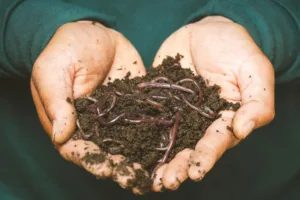Introduction:
The uppermost layer of Earth’s crust is made up of soil, which is a complex mixture of mineral particles, organic materials, water, and air. It is a dynamic, living environment that gives terrestrial life vital support.how soil is formed , Over time, rocks and minerals weather and break down, releasing a variety of mineral particles into the soil. The texture and structure of soil are influenced by these mineral particles, which include clay, silt, and sand.Decomposed plant and animal materials, along with living things like fungi, bacteria, earthworms, and insects, make up the organic matter found in soil. The addition of organic matter to soil improves soil structure, fertility, and moisture and nutrient retention
Under our feet, soil is something we frequently take for granted yet is essential to life as we know it. Its many functions from promoting biodiversity to aiding in agriculture—make it significant. More than just dirt, soil is a dynamic ecosystem that supports life in all its forms but do really know how soil is formed?
The soil condition all necessary nutrients for plant growth are stored in soil. It facilitates the breakdown of organic debris and replenishes the ecosystem with nutrients.Soil provides water, mineral nutrients, and anchoring for almost all terrestrial plants. A healthy soil gives roots a favorable environment in which to grow, allowing plants to develop and yield nourishment.
The flow and quality of water are greatly influenced by the soil. Water seeps through its layers, acting as a natural filter to remove pollutants and contaminants. In addition, by storing and releasing water as needed, soil helps control the amount of water available, averting both floods and droughts. The soil is brimming with life, including insects, earthworms, and microbes. It supports biodiversity and ecological equilibrium by providing a home and food for a wide variety of species.
Process: How soil is formed
The soil formation takes place by the process weathering ,it be physical weathering chemical weathering and biological weathering. This process is also know as pediogens
Physical Weathering:
Through mechanical processes including freeze-thaw cycles, abrasion by wind and water, and root growth, rocks and minerals are broken down into smaller particles. Rocks break and crumble due to these physical pressures, progressively creating soil particles.
Chemical Weathering:
When rocks and minerals come into contact with oxygen, water, acids, and other chemicals, chemical weathering takes place. Mineral structures are dissolved or altered by processes such as hydration, hydrolysis, oxidation, and carbonation, which weaken the minerals and make it easier for them to break down into soil constituents.The physical and chemical deterioration of rocks is aided by living things such as plant roots, burrowing animals, and microbes. This process is known as biological weathering. As microbial activity occurs, plant roots enter rock fissures, applying pressure and quickening mechanical degradation
Other important process for soil formation:
Buildup of Organic Matter: Decomposing plant and animal materials adds to the soil’s organic matter buildup. Organic matter is integrated into the soil matrix by plants losing their leaves, stems, and roots as well as by animals dying and decaying.Plants and other soil creatures can obtain nutrients from organic materials. By increasing aggregation and water retention capacity, it strengthens the structure of the soil.Organic matter is broken down by microorganisms, which releases nutrients that are necessary for plant growth, like phosphorus, potassium, and nitrogen
It is crucial to comprehend how soil is created for a number of reasons: Farmers can optimize agricultural techniques, such as crop rotation, soil conservation, and nutrient management, to sustain soil fertility and production by understanding the processes that lead to soil formation.
Ecological Management: Ecologists can more effectively protect and rebuild natural ecosystems by understanding the elements that influence soil formation. This knowledge contributes to the preservation of soil-based ecosystem services and biodiversity.Land Use Planning: To make well-informed judgments about land use and development, policymakers, land managers, and urban planners rely on knowledge of soil formation. Knowing the properties of soil aids in preventing landslides, soil erosion, and other environmental dangers.
Importance of soil:
Water:
Soil serves as a storehouse for water, retaining moisture necessary for the growth of plants and other soil organisms. Water seeps through soil pores and the crevices between soil particles, hydrating plants and making it easier for them to absorb nutrients.Air: Air-filled pockets exist in soil and are necessary for soil organisms and plant roots to breathe. For aerobic respiration, which allows organisms to break down organic materials and generate energy, oxygen in the soil is essential.
Supporting Plant Growth:
The soil gives plant roots a physical anchor and offers vital nutrients for development. The organic matter in the soil releases nutrients as it breaks down, maintaining plant health and productivity, while the mineral components act as a medium for root penetration and anchorage.
Water Filtration:
Water seeps through the soil profile and is naturally purified by the soil. Pollutants, silt, and other materials are captured and absorbed by soil particles and organic matter, keeping them out of surface and groundwater sources.In terrestrial ecosystems, soil is an essential component in controlling water flow. It helps lessen floods and droughts by absorbing and storing rainfall, which lowers runoff and erosion. It also releases water gradually.
Habitat for animals:
From microscopic bacteria and fungus to bigger animals like earthworms and insects, soil offers a diverse habitat for a wide range of organisms. These soil creatures are vital to the decomposition, soil formation, and cycling of nutrients, which enhances the general well-being and productivity of ecosystems.In conclusion, soil is a crucial part of terrestrial ecosystems because it facilitates plant growth, filters water, and provides a home for a wide range of species that are necessary for life as we know it. Its intricate makeup and range of roles highlight how crucial it is to maintaining the health and vibrancy of the planet’s ecosystems.
Factors affecting soil formation
The process of soil formation is influenced by various factors
Temperature:
The rate at which biological and chemical processes that produce soil occur is influenced by temperature. The disintegration of rocks and minerals occurs more quickly in warmer climates due to the acceleration of chemical weathering processes. The activity of soil organisms is also influenced by temperature, with warmer temperatures typically encouraging increased biological activity.
Precipitation:
By aiding in the weathering and erosion processes, precipitation affects the formation of soil. Sufficient precipitation facilitates the disintegration of rocks and minerals on a physical and chemical level, which releases nutrients and forms soil particles. On the other hand, too much rain can affect soil fertility by causing nutrient leaching and soil erosion.
Parent source:
One of the main factors influencing the composition of soil is the parent material, which consists of the underlying rocks and minerals. Unique mineral components and physical attributes of the soil are contributed by various parent material types. For instance, parent material based on granite may generate sandy, well-drained soils, but parent material based on limestone may result in alkaline soils that are high in calcium carbonate.
The parent material’s chemical makeup and structure affect the pH, texture, and availability of nutrients in the soil, which in turn shap,es the final soil’s fertility and productivity.
Biochemical Elements:
The roots of plants physically fracture rocks and open up soil pores to allow for the absorption of nutrients and water. Additionally, plants add organic matter to the soil by producing root exudates and leaf litter, which improves soil fertility and helps soil microbes.
Animals:
The aeration of soil, cycling of nutrients, and decomposition of organic matter are all greatly aided by soil-dwelling species such as earthworms, insects, and burrowing mammals. Their actions enhance the fertility and structure of the soil.
Microbes:
By breaking down organic materials, bacteria, fungi, and other microbes release nutrients and aid in the aggregation of soil. Additionally, they take part in other biochemical processes necessary for soil fertility and plant growth, such as nitrogen fixation.
summary:
In conclusion, soil composition, structure, and fertility are shaped by a combination of weathering processes, organic matter accumulation, translocation, and soil profile development. These factors eventually affect the soil’s capacity to support plant growth and maintain ecosystems.

